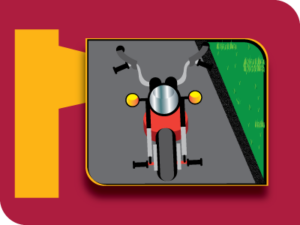For some, motorcycles can provide a sense of freedom and connection to the open road. They can also present higher risk of injury or death in the event of a crash. Because of these safety concerns, it’s critical for motorcycle riders to adopt a proactive approach to safety. According to Zero Deaths Maryland, “each year in Maryland, more than 70 motorcycle riders and passengers are killed in traffic crashes and nearly 1,000 riders and passengers are injured.”
Here are essential safety tips every motorcyclist should follow to enjoy the ride and get home safely.
Gear Up for Protection
Motorcycle gear isn’t just for a cool aesthetic. It also provides a layer of protection. Before revving your bike, ensure you are fully equipped with the right gear.
- Helmet: Always wear a Department of Transportation (DOT) -approved helmet that fits snugly. The National Highway Traffic Administration (NHTSA) conducted a study finding that motorcyclists who wore helmets were less likely to experience facial and head injuries than those not wearing helmets. Operating or riding a motorcycle without a helmet that meets the DOT’s safety standards is illegal in Maryland. NHTSA put together a guide to help you choose the right motorcycle helmet to provide maximum safety and comfort for your ride.
- Jacket and Pants: Invest in well-fitted, abrasion-resistant clothing, preferably made from leather or reinforced synthetic materials.
- Gloves: Protect your hands with gloves that offer both comfort and protection.
- Boots: Footwear should cover your ankles and provide good grip on the bike’s controls and foot pegs.
Get Proper Training
Whether you’re a newbie or an experienced rider looking to improve your skills, proper training is essential. Certified motorcycle training courses teach you the basics of bike handling and defensive driving techniques. Hone your skills through practice in a controlled environment, like an empty parking lot, which will build your confidence and ability to handle unforeseen situations.
Anyone operating a motorcycle in Maryland must have a Class “M” License. Those seeking to obtain a Class “M” License can take an entry-level basic rider course through the Maryland Department of Transportation Motor Vehicle Administration (MDOT MVA) or through an approved provider.
Conduct a Pre-Ride Check
Before hitting the open road, ensure that your bike is safe and working properly through a pre-ride inspection.
- Check tires for any signs of wear or damage, and make sure the pressure is correct.
- Confirm that all your lights, including turn signals and brake lights, function properly.
- Check oil, coolant, and brake fluids.
- Inspect your brakes and chains for any irregularities or excessive wear.
Ride Defensively
On the road, assume that you are invisible to other drivers. Always be alert and watch out for vehicles changing lanes or merging unpredictably. Keep a safe distance from other cars and anticipate possible hazards. Make yourself a beacon by using your headlight during the day and consider reflective gear or a high-visibility vest.
Respect the Road
Speeding is a major factor in motorcycle accidents. Obey traffic laws, maintain a safe following distance, and be extra cautious at intersections. Remember that road surfaces can change—watch out for gravel, potholes, and slick spots caused by rain or oil spills.
Rain, wind, and extreme temperatures can significantly impact handling. Avoid riding in bad weather whenever possible. If you must ride in inclement weather, adjust your speed, and don’t make any sudden movements, such as hard stops or sharp turns.
Gearing up properly, ensuring your motorcycle is in top condition, and adhering to safe riding practices can significantly reduce your risk of an accident or injury. Always remember that the road is a shared space, and safety is a joint responsibility between all road users.
For more information, check out:
- Zero Deaths Maryland
- Maryland MOTORS
- Maryland Department of Transportation Motor Vehicle Administration
- Maryland Motorcycle Operator Manual
- Motorcycle Safety Foundation
- National Highway Traffic Safety Administration
- National Safety Council




